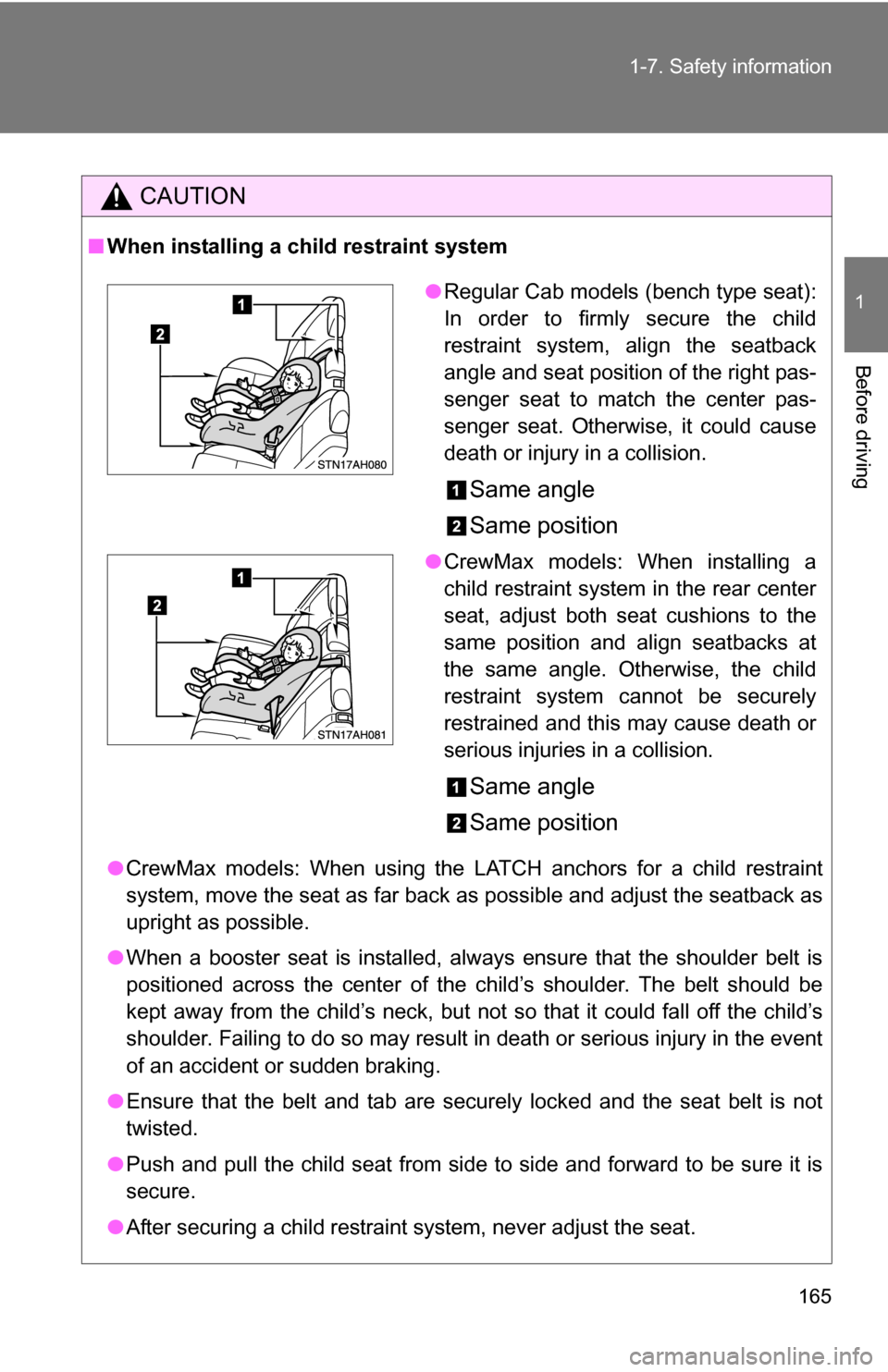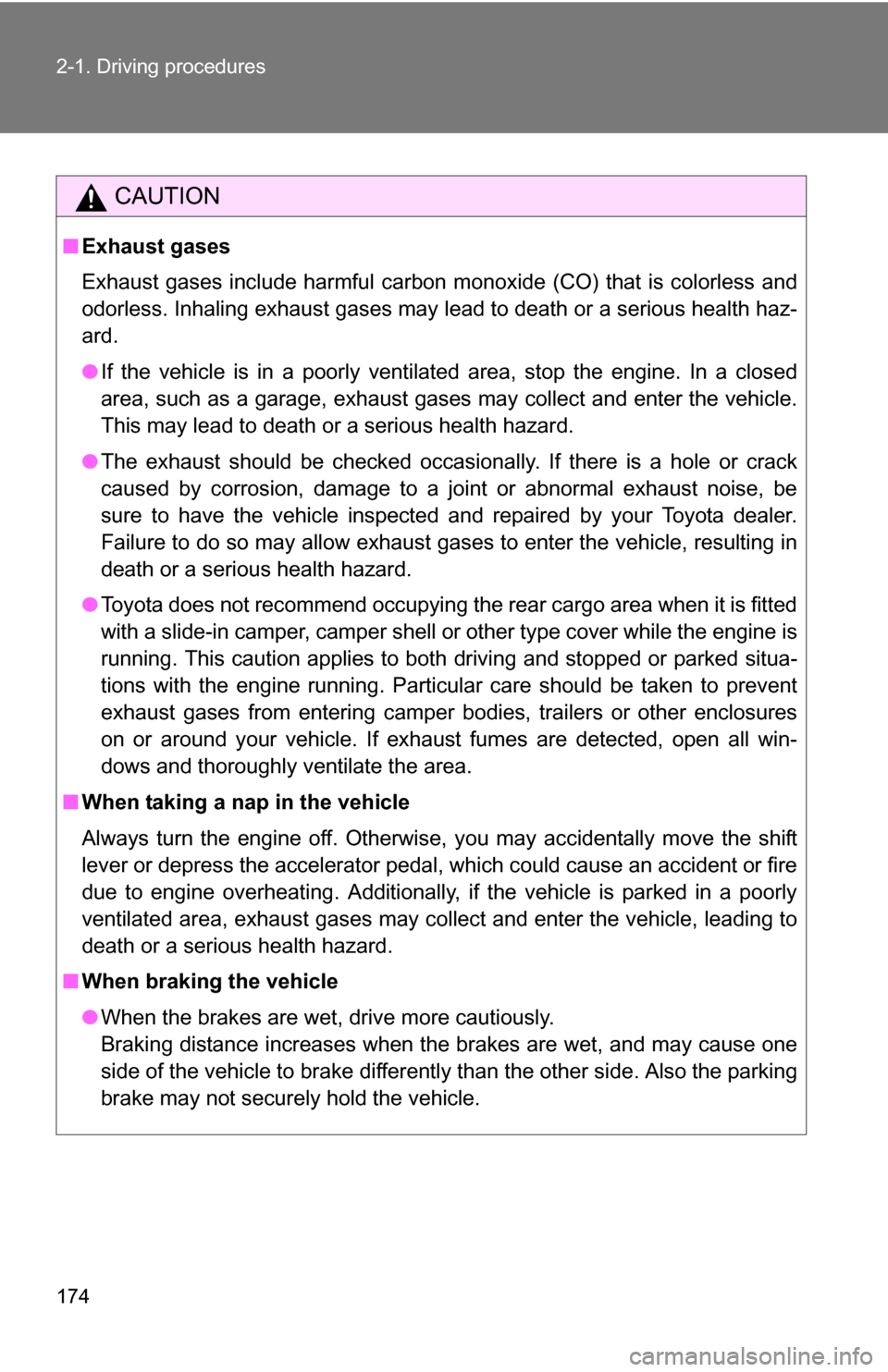Page 160 of 672
160 1-7. Safety information
Center rear seatLatch the hook onto the inner
anchor strap ring and tighten the
top tether strap.
Make sure the top tether strap is
securely latched.
Inner anchor strap ring
Lower the head restraints of right
and center seats.
■ Left rear seat
Raise the head restraints of cen-
ter and left seats.
Page 161 of 672
161
1-7. Safety information
1
Before driving
Pull up the straps of center and
left seats.
Route the top tether strap
through the routing device as
shown in the illustration.
Make sure the top tether strap is
not twisted.
Routing device
Latch the hook onto the inner
anchor strap ring and tighten the
top tether strap.
Make sure the top tether strap is
securely latched.
Inner anchor strap ring
Lower the head restraints of cen-
ter and left seats.
Page 162 of 672
162 1-7. Safety information
Child restraint systems with a top tether strap (CrewMax models)Remove the head restraint.
Installing position:Outside passenger seat
Center passenger seat
Outside passenger seat Swing the seatback forward
slightly. (P. 63)
Open the anchor bracket
cover.
Latch the hook onto the
anchor bracket.
Return the seatback to its orig-
inal position.
Make sure the seatback is
securely locked by pushing for-
ward and rearward on the top of
the seatback.
Page 163 of 672
163
1-7. Safety information
1
Before driving
Center passenger seat
Swing the seatback forward
slightly. (P. 63)
Open the anchor bracket
cover.
Latch the hook onto the
anchor bracket.
Return the seatback to its orig-
inal position.
Make sure the seatback is
securely locked by pushing for-
ward and rearward on the top of
the seatback.
Secure the child restraint using LATCH anchors ( P. 151) or
a seat belt ( P. 154), and tighten the top tether strap.
Make sure the top tether strap is securely latched.
Replace the head restraint.
Installing position:
Outside passenger seat
Center passenger seat
■Laws and regulations pertaining to anchorages
The LATCH system conforms to FMVSS225 or CMVSS210.2.
Child restraint systems conforming to FMVSS213 or CMVSS213 specifica-
tions can be used.
This vehicle is designed to conform to the SAE J1819.
Page 164 of 672

164 1-7. Safety information
CAUTION
■When installing a booster seat
Do not fully extend the shoulder belt to prevent the belt from going to ALR
lock mode. ( P. 79)
● ALR mode causes the belt to tighten only which could cause injury or dis-
comfort to the child.
■ When installing a child restraint system
Follow the directions given in the child restraint system installation manual
and fix the child restraint system securely in place.
If the child restraint system is not correctly fixed in place, the child or other
passengers may be seriously injured or even killed in the event of sudden
braking or an accident.
●Double Cab and CrewMax models: If
the driver’s seat interferes with the child
restraint system and prevents it from
being attached correctly, attach the
child restraint system to the right-hand
rear seat.
● Double Cab and CrewMax models:
Adjust the front passenger seat so that
it does not interfere with the child
restraint system.
● Only put a forward-facing or booster
child seat on the front seat when it is
unavoidable. When installing a forward
-facing or booster child seat on the front
passenger seat, move the seat as far
back as possible even if the AIR BAG
OFF indicator light is illuminated. Fail-
ing to do so may result in death or seri-
ous injury if the airbags deploy (inflate).
Page 165 of 672

165
1-7. Safety information
1
Before driving
CAUTION
■
When installing a child restraint system
●CrewMax models: When using the LATCH anchors for a child restraint
system, move the seat as far back as possible and adjust the seatback as
upright as possible.
● When a booster seat is installed, always ensure that the shoulder belt is
positioned across the center of the child’s shoulder. The belt should be
kept away from the child’s neck, but not so that it could fall off the child’s
shoulder. Failing to do so may result in death or serious injury in the event
of an accident or sudden braking.
● Ensure that the belt and tab are securely locked and the seat belt is not
twisted.
● Push and pull the child seat from side to side and forward to be sure it is
secure.
● After securing a child restraint system, never adjust the seat.
●Regular Cab models (bench type seat):
In order to firmly secure the child
restraint system, align the seatback
angle and seat position of the right pas-
senger seat to match the center pas-
senger seat. Otherwise, it could cause
death or injury in a collision.
Same angle
Same position
●CrewMax models: When installing a
child restraint system in the rear center
seat, adjust both seat cushions to the
same position and align seatbacks at
the same angle. Otherwise, the child
restraint system cannot be securely
restrained and this may cause death or
serious injuries in a collision.
Same angle
Same position
Page 166 of 672
166 1-7. Safety information
CAUTION
■When installing a child restraint system
●Follow all installation instructions provided by the child restraint system
manufacturer.
● After securing the child restraint system, never slide or recline the seat.
■ Do not use a seat belt extender
If a seat belt extender is used when installing a child restraint system, the
seat belt will not securely hold the child restraint system, which could cause
death or serious injury to the child or other passengers in the event of a colli-
sion.
■ To correctly attach a child r estraint system to the anchors
When using the LATCH anchors, be sure that there are no foreign objects
around the anchors and that the seat belt is not caught behind the child
restraint. Make sure the child restraint system is securely attached, or it may
cause death or serious injury to the child or other passengers in the event of
a sudden stop or accident.
Page 174 of 672

174 2-1. Driving procedures
CAUTION
■Exhaust gases
Exhaust gases include harmful carbon monoxide (CO) that is colorless and
odorless. Inhaling exhaust gases may lead to death or a serious health haz-
ard.
●If the vehicle is in a poorly ventilated area, stop the engine. In a closed
area, such as a garage, exhaust gases may collect and enter the vehicle.
This may lead to death or a serious health hazard.
● The exhaust should be checked occasionally. If there is a hole or crack
caused by corrosion, damage to a joint or abnormal exhaust noise, be
sure to have the vehicle inspected and repaired by your Toyota dealer.
Failure to do so may allow exhaust gases to enter the vehicle, resulting in
death or a serious health hazard.
● Toyota does not recommend occupying the rear cargo area when it is fitted
with a slide-in camper, camper shell or other type cover while the engine is
running. This caution applies to bot h driving and stopped or parked situa-
tions with the engine running. Particular care should be taken to prevent
exhaust gases from entering camper bodies, trailers or other enclosures
on or around your vehicle. If exhaust fumes are detected, open all win-
dows and thoroughly ventilate the area.
■ When taking a nap in the vehicle
Always turn the engine off. Otherwise, you may accidentally move the shift
lever or depress the accelerator pedal, which could cause an accident or fire
due to engine overheating. Additionally, if the vehicle is parked in a poorly
ventilated area, exhaust gases may collect and enter the vehicle, leadin\
g to
death or a serious health hazard.
■ When braking the vehicle
●When the brakes are wet, drive more cautiously.
Braking distance increases when the brakes are wet, and may cause one
side of the vehicle to brake differently than the other side. Also the parking
brake may not securely hold the vehicle.